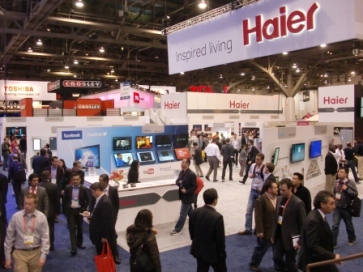Ah, 'is the season again. The Most Wonderful Time of the Year. A loud, crushing madhouse of new technology tumbling over itself. The Consumer Electronics Show in Las Vegas. Disneyland for Adults. Fa la la.
Wandering the bizarre circusworld, the only clear thing is what the first question will be shouted upon returning to reality. "So, what cool things did you see?!!" My definition of "cool" is far different from most, however. It's not the whizbang, that dazzles with high-tech amazement. To be clear, CES is filled with whizbang - from 3D everything to televisions that let you run your life without leaving your couch. What is cool to me are devices basic to your daily life that have been so vastly improved they make what you do profoundly easier. (For example, the Tagg Pet Tracker. It's just a collar, but uses GPS to locate your pet on a mobile device map or computer.) Such "cool" award winners will be sprinkled and addressed through this report.
The wonderful thing about CES is that there is plenty of both the cool and whizbang to satisfy anyone. And so, we jump off the ledge and dive in...
(First, though, our Annual Disclaimer: This overview will be long. Russian-novel long. No, seriously. I don't want to hear any whining, "Dear Lord, will this ever end?!" You've been warned. If you don't want "long," then stop now. Really. Otherwise, read on, MacDuff.)
Before CES began this year, there was general grumbling that there would be no "Next Big Thing" at the show. This was suggested to signify a problem not only with innovation, but for business sales, as well. The reality, though, is that there's a cycle to all this, and every few years there seems to be no "Next Big Thing." Partly, that's because technology moves so fast, it needs time to catch up, to mature itself. In part, too, is that the market needs time to catch up - the public has to figure out how a technology will fit into their lives...or if it will.
So, make no mistake, there was a massive amount of new, interesting technology. No "Next Big Thing," but a maturing process of several themes that broke through last year, most notably 3D, tablets and connectivity. Some of that maturing was richly impressive. Some raises questions.
Connectivity is probably the least flashy of themes at CES, but it's also the one every year that companies most push, because ultimately it's what impacts people's lives the greatest. The more that different technologies work easily together, the more people see a reason to use them - and are able to.
This can be in something as mundane as a home appliance. Yet Samsung's Home Net system combines iPhone apps with LCD touch screens that let you set wash cycles and temperature and dryer times from on-the-road, or use your refrigerator to watch TV, keep up with AP news, and be a smart "grocery manager," informing you when to shop for specific foods.
LG's ChevyMyLink lets you control your smartphone through your car radio, listen to Internet radio and watch movies. The Biscotti TV Phone attaches to your high-definition television and turns it into a videophone.
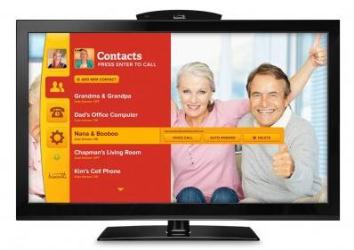
That's, of course, the everyday humdrum of connectivity, the ordinary that will change everyone's lives. But leaping up the flashy scale, one of the more prevalent uses of connected technology at CES is the fast-growing blending of TV, movies and the Internet. So blended that the process is seamless, making it unclear whether you're watching television or accessing the Internet.
One of the most impressive of these (getting it a "Cool Thing" award) is Fanhattan, which the company describes as "Kayak for movies" (referring to the website that consolidates travel information). An elegantly-designed free app, this is an all-in-one browser that collects information of what's available across a wide range of video content distributors - including Netflix, Hulu Plus, iTunes, Vudu, HBO Go, and all the TV networks - for streaming to your handheld device or Internet-connected television. Moreover, it also provides information on the content, merchandise to purchase and much more.

There is a now a massive explosion of similar products that blend the Internet with movies, TV and your home theater. For instance, mSpot streams movies to your smartphone or can download an entire movie in just three minutes for viewing later. Film Fresh is an interesting free, online service that, makes offbeat movie recommendations in helpful categories and streams them on your computer, but will be soon adding Internet-connected TV. Warpia streams high-def media wirelessly from a PC to your TV. Shodogg retrieves streaming video from a smartphone and allows you to watch the content on any connected device, while Simple.TV lets you store TV shows (like with a DVR) and then watch them on any connected device.
I mention all of these for a particular reason of interest to those working in the entertainment industry. A mere three years ago, the Writers Guild of America went on strike against the MPAA corporations when the companies offered (literally) "zero" for accessing content on the Internet. Corporate reasoning was that the Internet was such a new-fangled technology they couldn't understand the thing, and it was impossible to know if money could be made from it. (Later documents showed that the studios were already digitizing their libraries.) The big issue driving all this is the question of "what is watching TV" and "what is watching the Internet" if they're blended? If you watch a TV show live on your handheld - or even if you watch a movie on a television set but it's streaming from the Internet...is that watching TV, or the Internet, which has an entirely different set of standards for payment to the creative talent?
The point here is that, regardless of what Hollywood multi-national corporations try to plead to the contrary, the blending of TV, movies and the Internet is here today, and they are well-established as interconnected distribution outlets, with huge money already being earned from it. Watching TV on TV may well become a thing of the past. Watching TV online - or through your Internet-connected TV - is today, now, the reality.
And none of this takes into consideration that Netflix is spending $100 million (!) to produce a web series based on the brilliant British mini-series, "House of Cards," to star Kevin Spacey. And is producing another online series, "Lilyhammer." Similarly, Amazon and Google are moving into the arena, and Netflix has just introduced its service into the United Kingdom.
Furthermore, Microsoft announced at CES that it has joined with News Corp. to provide content and apps for all Fox TV services, distributing programs online through Xbox Live. And Disney has made a 10-year deal to offer its cable content to Comcast's members online
And all this from the corporations who just three years ago insisted that they need three years to simply "study" the Internet to see if there was a future there. Apparently they're quick studies...
And this connectivity between TV and the Internet goes even deeper.
An impressive new standard, called MHL, is being developed by a consortium owned by Sony, Samsung, Toshiba, Nokia and others. This will allow an MHL port on your TV to connect to your MHL-enabled handheld device and play your mobile content on a television. (Televisions with MHL ports are here today, but should be coming full-force into the market soon.)
Devices like Roku, Boxee, Apple TV, and Western Digital WD TV Live have been around for years, streaming movies and TV from online services to your television. In a separate direction, Syncbak is a developing technology already installed at 50 TV stations reaching 25 million homes. It works with mobile devices and Internet-enabled TV, allowing users on the road to watch television on their handheld.

Related to this is another area of TV that's slowly emerging - Mobile TV. The technology lets you watch television with a moving signal, like in a car. A few such products are out already, including Hauppauge's Aero-M. But Escort Mobile TV has joined the fray. The device is attached to your handheld, and you download the appropriate app for viewing. Right now, there are limited stations that air Mobile TV broadcasts, but it has been developing for several years.
Of course, when it comes to TV, the Big Kahuna at CES is another of those main themes - 3D-TV. The technology made its huge splash at the 2011 show. It's now had a year to mature and help establish a foothold in the marketplace. It's this latter, however, that is proving a challenge.
As I wrote extensively last year, impressive as 3D-TV is (and make no mistake, it is), there remains a huge question of if there's a market for it...or ever will be. To very briefly summarize some of these issues - 1) People were just convinced to buy expensive HD televisions, so they're not going to immediately get an even more expensive 3D set. 2) Wearing cumbersome 3D glasses is not how people watch television - they wander around, chat, and read at the same time. 3) If you invite friends over to watch TV, most homes won't have enough 3D glasses. 4) 3D-TV works wonderfully, but it works best from specific viewing areas. 5) There's little 3D content on television today, other than ESPN 3D (which is one of the very few types of content that even justifies 3D on television). And 6) It may take five years to get all these issues resolved, an eternity in technology, allowing something else to develop instead.
To make this theoretical discussion personal, I spoke with someone at CES who said her mother bought a 3D TV last year. "It was the worst purchase she ever made!" she moaned. "Terrible." At a Super Bowl party, people had to pass around the glasses, sharing them. "The rest sat there looking at a fuzzy screen."
That said, 3D technology with glasses does look terrific. And the future of all this can certainly change. Moreover, there are now a massive amount of different sets on the market - all of them looking so vibrant that it's hard to distinguish between the onslaught. A few things about 3D-TV did stand out, though, even if in a small way.
Oddly, with all the massive razzle-dazzle pummeling the crowd with 3D, it was one of the simplest things that gets another "Cool Thing" award. Volfoni came up with a solution facing all those people who wear prescription glasses and have a near-impossible time with the required 3D eyewear - the company developed 3D clip-ons!
For all the issues with 3D-TV, however, there's one area worth keeping an eye on (no pun intended) - 3D-TV without glasses. At the moment, the technology is in its infancy, though it's intriguing. What Toshiba demonstrated worked extremely well - but only as long as you stood in one of three narrow spots. Move three inches in either direction, and you lose the 3D effect. LG had its displays, as did several others, like TCL which showed its "virtual holographic TV."
But that brings us to one of the wonders of CES. It's a company you've never heard of, Stream TV Networks, who last year wasn't even located with other TV companies, but off with the tablets. They demonstrated their glassless 3D-TV in a little room, and though rough, it worked pretty well. This year, however, their Ultra-D brand has widely expanded, and their technology was notably improved. How in the world an unknown company has succeeded where the Big Boys haven't is the remarkable question. The best I can figure is that while others have been devoting their Research & Development for 3D-TV with glasses, Stream TV focused instead on glassless technology. In doing so, they get a "Cool Thing" award.
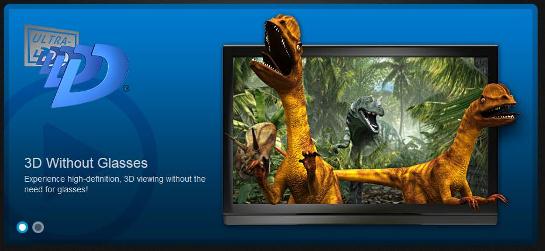
The thing is, it's not just Ultra-D is better than the Big Boys - it's that there's no comparison. First, they have a glassless 3D technology that actually works, and works right now. To be clear, it's not remotely as vivid an effect as 3D with glasses, and there's big room for improvement. But it is 3D, it's watchable from a reasonably wide viewing angle, and they had it running on a converted-from-2D version of a "Harry Potter" movie. More than that, Ultra-D has resolved some of the other issues of 3D-TV, as well. Built into the system is technology that will convert in real time any 2D content into 3D. So, you can watch anything in 3D. It also lets you adjust the 3D for your visual preference, with bigger and flashier "pop" but more distortion, down to limited distortion, but less of a pronounced 3D smaller pop out of the screen. Also, Ultra-D can turn off 3D completely, so that you can watch normal television, rather than get that fuzzy image. The company doesn't manufacture sets itself, but is in talks with possible partners who would market their sets as "built with Ultra-D." The technology still has a ways to go to be a rich experience, but the unknown Stream TV Networks has taken it great strides - and most bizarrely, taken its strides far in advance of the big names.
Mind you, TV isn't the other technology using 3D. Camcorders are beginning to make a fairly wide appearance, like the JVC GSTD1. Its viewfinder plays back your image in glassless 3D, although the image seemed more fuzzy than ideal. DXG USA gets around that with its DXG 3D camcorder, whose viewfinder image seems sharper.
By the way, you may have noticed that that was the first mention of a camera here. It will also be the last. There are two technologies beyond massive at CES - digital cameras and phones. Scary oceans of them. And the technologies of both are so mature at this point that even the least of them are impressive. One blends into the next. And so, I avoid digital cameras and phones.
(Actually, there's one other area at CES that was overwhelming, as well. I'll leave that be for the moment, though, and let you guess. It'll give you something to do, other than reading all of this. It won't be what most people will expect.)
That brings us to the last of the main themes at this year's show - tablets (and ebook readers). The reality, at this point in their development, is that tablets have a lot of similarity. Clearly there are best-selling models, from Apple's iPod to the Android devices like Samsung's Galaxy Tab, the Kindle Fire, and Nook Color. What separates the range of models right now seems to be whether a device is high end with more options and 3G connectivity, or more affordable, with fewer features but highly accessible.
In this sea of tablets and ebook readers, a few items stood out, not because they were inherently better or not, but offered something different.
I'm actually more partial to ebook readers than tablets, most especially if one mainly wants to read digital books. A French company, Bookeen, will be introducing its touchscreen ereader, the Cybook Odyssey, currently sold in Europe. The company has developed a high speed e-ink system, along with a fast processor that allows for extremely fast page turns, so much so that little animations are even possible. Pricing will depend on several partnering issues, but the company expects the range to be between $120-149.
However, the most intriguing entry in the tablet world I came across is the Kupa X11. In fact, it's one of the few tablets that I find usable in a work environment. That's because it's a Windows tablet. A demo model was running a beta version of Windows 8, which worked nicely, though because it's still in development there were some Microsoft-related glitches. However, in my brief run-through of the tablet running Windows 7, it was extremely stable and ran beautifully.
Here's why this is important, and why the Kupa X11 is a "Cool Thing" winner for me. Apple and Android tablet are basically content devices, for accessing the Internet, videos, reading books and such. But you can't really do serious productivity on them. The Kupa X11 has a touch screen like any tablet, but being Windows, you can use it like any Windows PC. There is a dearth of Windows-based apps (that will no doubt change when Windows 8 is released), but here's the thing - you don't need apps: being Windows, it runs your normal software. For example, let's say you're a writer who uses Movie Magic Screenwriter or Final Draft for your work. That's not possible on an iPad or Android tablet - there are no apps in existence for them. But with the Kupa X11, you simply install the software, same as on any PC. Attach a portable keyboard to your tablet, and you can do actual, real, serious work anywhere. It has a 10-hour continuous operation battery and 30-day standby. (Prices start at $700 for 64 GB and Wi-FI, up to $970 for 128 GB and 3G/Wi-Fi.)
(There are a few other Windows tablets available now, such as one from Archos, though I didn't get a chance to test them. However, it seems likely that when Windows 8, which is being developed to work on tablets, nears release, more such tablets will be coming to the market.)
When it comes to work, of course, creating a home office is the mother ship. (This doesn't mean just working at home, but also creating a set-up for when you have to take your office on the road.) It's also one of the environments I particularly enjoy because there tends to be a lot of innovation here in devices that people use regularly.
For instance, two more of my "Cool Things" reside here, for that very reason. Neither are remotely flashy - pretty banal on the surface, in fact - but how they take standard office products and ratchet them up in usability is a treat.
What the Lantronix xPrintServer lacks in an interesting name it makes up for in taking a great need and resolving it. That's why it's a "Cool Thing" winner. If you've ever created a document on your iPad or iPhone and wanted to actually do something with it, like print it out, you've generally been out of luck. With the xPrintServer, however, plug the device into a router, download an app, and that's it. You can now you can now just tap on the document in your iPhone and print it out. It retails for $150. The company will soon be releasing an Android version. (Now, if only they can come up with a better name...)

The other "Cool Thing" award goes to a product that's just as bland. Pandigital's Handheld wand scanner with feeder dock. (The name trips off the tongue.) The issue with most scanners is whether to get a flatbed or sheet-feeder model. But the Pandigital wand scanner (which you slide by hand over a page) can also be placed into a dock, turning it into a sheet feeder. An LCD screen displays the image of what was scanned. Also, an issue with wand scanners is that you need a hand so steady it would make a brain surgeon jealous. The Pandigial is so solid that I rolled it across a desktop, and it didn't waver. For those who have to work when traveling, this is a gem of a clever idea. It retails for $129.
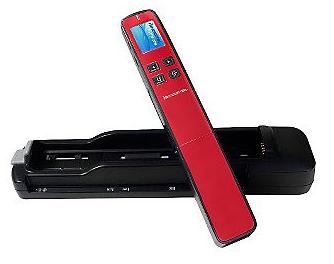
Also useful and well-designed is Kingston's Wi-Drive. It expands the limited capacity of an iPad or tablet. The Wi-Drive connects wirelessly by Bluetooth to your iPad - then, using the free iOS app, you can access any content on the drive. (An Android app is available in beta test form, but will be available soon.) Though not huge capacity (coming in 16 or 32 GB size, for $60 and $90 respectively), the device is a solid state drive, which is tiny and light. So small you can easily keep it in your shirt pocket.

Scrible is a free web application that doesn't require any installation. Basically, it's a bookmark for your browser that "overlays" your monitor. If you do a lot of online research, Scrible lets you highlight text on a webpage, make annotations and organize them all so they're easy to find later. An iPad app is also available.
For privacy worshipers, SurfEasy lets you go on any computer and surf the Internet anonymously, without leaving any footprint behind. Everything (including a Firefox browser) is stored on a device that you encrypt with a password and then plug in. It retails starting at $60 for 2 GB of usage a month, with premium pricing above that as needed.
There was also a notable increase in cloud-based services, where your content is stored on servers over the Internet to keep you connected to your data wherever you are. Familiar standbys like Pogoplug, Dropbox, [www.dropbox.com] SugarSync and iTwin (a slightly different concept that connects you to another computer using two "keys" you plug into USB ports of each) are the long-time foundation of this field, but it's expanded so greatly that it's lead to a hopeful startup, Primadesk that consolidates all your cloud services in one site.
Okay, if you want to take a break here - let's call it the Seventh Inning Stretch - feel free to exercise your legs. Take a break, get a snack. I'll wait...
During the break, though, I'll now give the answer to that third area of products so massive it was like being swallowed by an ocean. Ready? Cases for cell phones. Honest. (How many guessed that? Hands?) The numbers were bizarre. Two separate companies even had cases perfumed to smell like jelly beans. Fun fact: there are more cell phones than people in the U.S. Apparently, there are now more cases than cell phones...
Okay, we're back.
Though we just left the home office, it's nonetheless worth mentioning the Logitech K750, which is a solar keyboard for Macs.
I note this because there was a growing presence of green products at CES, something almost incongruous in a world of electronics. For instance, Samsonite makes some luggage that has solar panels on the outside to charge small devices. (It's for direct charging only, though, because the panels don't hold a charge.)
The most interesting solar charger I saw was from Revolve, an "Earth Friendly" company with a full line of high quality solar products. Its xeMilo is a small, portable, solar battery pack rated at 4400 mAh (milliamp), which means it's powerful enough to charge a tablet. It can charge itself with either a solar panel, AC or from a car; can charge two devices at once, and retails for $100. What makes the product so intriguing, though, is that it can work in conjunction with the Sol-Sport 5 that Revolve introduced at the show. (Tech note: solar charging works best the more surface area there is, to collect the energy.) The Sol-Sport 5 is a wafer thin panel that opens like a magazine, creating a large surface area - connect your xeMilo to it, and the charging time is cut by two-thirds.
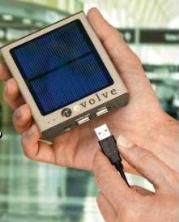
Also growing in numbers are green batteries, made without mercury, lead or other harmful chemicals, and can be disposed without danger to the environment. Last year, I noted ecoAlkaline, which works with Carbonfund.org. Now cropping up are similar items from Evergreen and Perfpower.
For those less green-motivated, impressive leaps were also made in the more normal type of charger. (For reasons semi-inexplicable, this is a field that fascinates me. In part it's because technology has become so portable that I find it important for portable power to keep pace.)
Two stood out. One, the Mophie juice pack powerstation is a high-output charger with a battery of 4,000 mAh so it can handle charging a tablet. There are two ports - for USB and mini-USB. The remarkable thing, though, is how small it is, about the size of an iPhone. In a world of portability, where devices keep getting smaller, this is no minor consideration. It retails for $80.
The other, the myCharge Portable Power Bank 6000, has a serious 6,000 mAh battery that can charge a tablet or provide four charges to a smartphone. But what's so special is that it has built-in Apple, USB mini and USB micro plugs, so there's no need to carry cords around. If a device does require a cord, there's also a USB port. It's extremely portable, though a little bulky, about the size of a very large deck playing cards, and retails for $100. Upcoming, the company has a similar unit that, remarkably, will also have a built-in wall charger, so it will truly be self-contained.
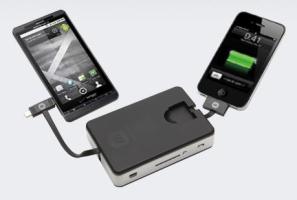
(By the way, myCharge also makes a line of Powerbags that have built-in chargers, so you can recharge your devices while they sit in your luggage.)
Don't worry, we're nearing the end. The finish line is in sight.
I was uncertain whether to mention the Eton Soulra X1 in the discussion of solar devices, but figured it was best to hold off until getting around to speakers. Eton is a company that makes wonderful "green" equipment, some of it solar powered, some with a hand-crank generator. The Soulra XL is a sound system for the iPad/iPhone using a solar panel that provides energy for five hours of runtime. With eight strong speakers, it retails for $250. (Eton's Rukus Solar will connect to any music source by Bluetooth. It has two speakers and retails for $150.)
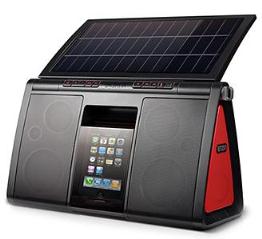
One of my favorite audio companies for the past few years has been the small, but growing X-Mini. They began life with a tiny capsule speaker the size of a golf ball, but which puts up stunning sound for a device that small. The latest additions to their line are the Rave, which has a built-in FM radio, and the Kai. This latter connects to your sound source by Bluetooth - but also, with the touch of a button, it will shut off the audio when a phone call comes in and turn into a speaker phone. Both of these remain about the size of a golf both.
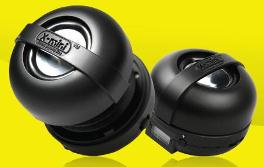
And that brings up what is this year's winner for the goofiest product at CES. Unlike all past winners, however, this is not goofy in usage. Indeed, it's just a small stereo speaker. It wins based on a first - its name, as well as a concept that turns goofy into brilliant. The company is Uncle Oswald is My Hero. (Yes, that's its real name. It comes from a character in a short story by Raold Dahl. The South Korean founders get major literary points for this.) And what the product is - they bought up large batches of heavy, solid handsets from old telephones from AT&T, Northern Electric and ITT...and turned them into stereo speakers. The product, called the Dreyfus Special (named after an industrial designer), is an honorable mention winner of the prestigious Red Dot Design Award. As a start-up, they're in talks to get a manufacturing partner, but they're certainly off to a noteworthy start. Including the opening line in their press release, the first I've ever quoted in a CES report: "Jinsop Lee and Justin Kim endured two years in the army without killing anybody. In between all the toilet scrubbing and not killing of anybody the two of them hatched a grand plan to one day start design company."
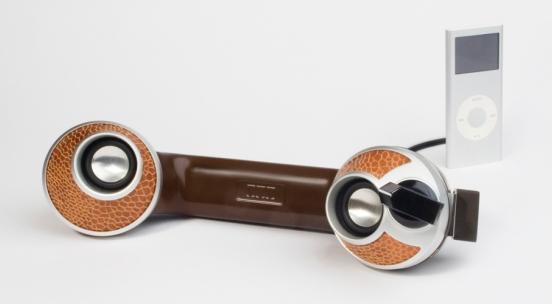
That leaves one remaining award winner. The Least-Likely Product to Be at CES. And this year, that honor goes to...Schick razor blades. Their Hydro 5 disposable razor now comes in a battery-operated model. The Hydro 5 Power Select lets the user adjust speeds that the razor head will vibrate and massage the face.
And now, speaking of massages, it's time to rest. And thus ends the electronic tale that is CES 2012.
* * *
"The Writers Workbench" appears monthly on the website for the Writers Guild of America. To see this entire column, with complete product graphics and additional "TWW Notes," as well as previous columns, please click here

